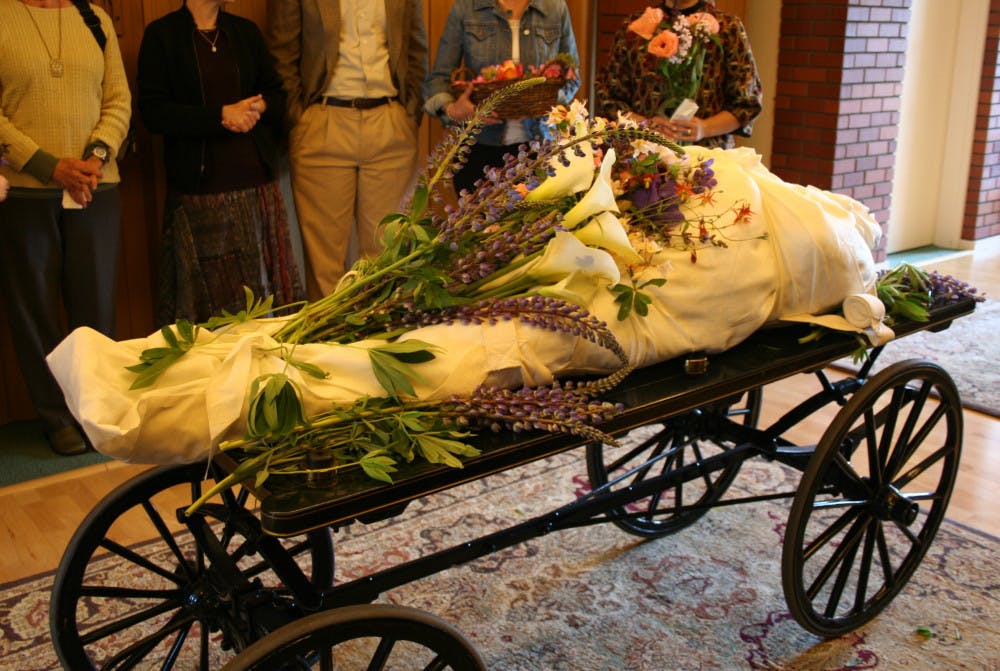Green ways to leave this world without disturbing mother nature

Steve Webster gently pushes the long steel tray where the lifeless body lays, covered with a biodegradable sheet. The tray slides inside the machine’s 7-feet-long tube. He closes its round door — the same type of door used for submarines.
Webster goes to the screen on the side of the machine. He types the deceased’s name, their date of passing, their sex and weight. Once he’s done, he activates the machine.
A stream of water with a 320° Fahrenheit submerges the deceased. The water’s pressure, as Webster says, is similar to a garden hose, or a faucet. Immersed in about 80 gallons of water, the body begins decaying under the action of potassium hydroxide — a corrosive chemical — which is also used to make soap.
As soft tissue breaks down, the water turns into a brownish liquid made of the basic building blocks of the human body. About four hours later, the machine returns 100% of the bone structure which is 20% more than a cremation would return.
The remaining bones are almost in the same position as they were before they were undressed of their cover of skin and flesh. The mortician removes the bones and takes them to be fragmented into a white powder and placed inside an urn.
The process is a revolutionary method of taking care of our dead: aquamation. This is alkaline hydrolysis, which is also, bio cremation, water cremation or resomation, and Webster is in charge of the process at The Co-op Funeral Home of People's Memorial in Seattle.
Rachel LeBlanc, funeral director intern at the same funeral home, said the byproduct of aquamation is a sterile liquid that is environmentally safe, and that can be poured down a municipal wastewater system.
“What’s nice about the machine,” Webster said, “is that it’s fully adaptable.” The machine in fact could operate with alternatives to potable water, such as the relatively clean waste from the sink or the washing machine, to avoid wasting this resource as it becomes more scarce.
Webster said that several clients choose aquamation because they are afraid of fire and want a gentler process, or because of the environmental benefits, or simply because they’re “in love with the water.”
LeBlanc took care of the first aquamation client in Washington in October 2020. The practice became legal in the state in 2020, she said.
Aquamation is similar to fire cremation, as they both are implemented to rapidly break down the body, LeBlanc explained. However, unlike fire cremation, aquamation releases zero emissions and utilizes an eighth of the energy typically used in a fire cremation.
According to the Cremation Association of North America, cremation is the new burial tradition, as cremation growth rates in the country went from 31.2% in 2004 to 54.6% in 2019.
Brian Flowers, the Managing Funeral Director at Moles Farewell Tributes in Bellingham, said for a long time the environmental impact of cremation was considered to be lesser than with conventional burials. However, he said, crematories consume 54 gallons of fuel to cremate one body, and all the toxins contained in the body — even the mercury in their dental fillings — become emissions.
According to The Green Burial Council, an international non-profit that certifies green burial offerings, cremations release 1.74 billion pounds of CO2 emissions every year in the U.S.
Conventional burials aren’t eco-friendly either, according to Mary Woodsen. Every year in North America, conventional burials use 4.3 million gallons of embalming fluid, 20 million board feet of hardwoods, 1.6 million tons of concrete, 17,000 tons of copper and bronze and 64,500 tons of steel, according to Woodsen.
To give a visual understanding of how much embalming fluid is used, 4.3 million gallons can fill 107,500 bathtubs, according to the U.S. Geological Survey.
Flowers said that the process of decay in a sealed environment takes years, during which the body goes through liquefaction.
“The anaerobic bacteria in that liquid will corrode any container despite the 50-year warranty that might come with the casket or the vault,” Flowers said. Once the liquid is out, it will permeate down into the water table, contaminating it.
Within the funeral industry, proponents of sustainable funeral practices have come up with creative ideas to minimize the environmental impact of cremations and conventional burials.
Recompose is a Seattle funeral home that has been composting human bodies since December 2020. It’s the first human composting facility in the world.
In 2019, Governor Jay Inslee signed a bill that legalized natural organic reduction, making Washington the first state in the world to do so.
According to Recompose’s website, human composting works this way: the body is placed on and covered by organic matter inside a steel cylinder, where it naturally decomposes over 30 days. Microbial activity causes the temperature to rise above 131° Fahrenheit, killing most pathogens. Pathogens responsible for diseases like tuberculosis and Creutzfeldt-Jakob Disease are not good candidates for human composting, as they can’t be neutralized in the process.
Recompose’s website explains that microbes break down the tissue and turn it into one cubic yard of nutrient-rich soil that is left to aerate before being used for conservation purposes, or returned to the deceased person’s family. In addition, they explained that human composting over unsustainable practices saves one metric ton of carbon dioxide, and requires an eighth of the the energy consumed by conventional burial or cremation.
Since western society fixates on youth and excellence, death is a taboo topic for many, as Anna Citelli and Raoul Bretzel, creators of Capsula Mundi, wrote in an email. To reconcile people and death, they designed a biodegradable and egg-shaped urn called the Capsula Mundi, which is put on top of a planted seed. “The egg is a universal symbol of rebirth. Nature is continuous movement, and death is the transformation of matter,” Citelli and Bretzel wrote.
Once buried, the eggshell — containing cremated remains — begins to break in a slow process, allowing the soil to gradually mix with the ashes, Bretzel and Citelli said.
Flowers explained that cremated remains contain high acidity and salt. He said when cremated remains are scattered in a non-aquatic natural environment, one needs to be careful. Cremated remains carry no nutrients for plants and can be toxic to roots unless evenly mixed with the soil.
“All the salt in our body concentrated into about seven pounds of material,” Flowers said.
The creators of Capsula Mundi said the egg allows for the soil to neutralize cremated remains’ high acidity. Rainwater dissolves sodium and potassium salts, fostering the plant’s growth.
Capsula Mundi is currently testing an egg to contain a whole human body.
The Meadow Natural Burial Ground in Ferndale, a funeral home Flowers designed, is Western Washington’s first natural burial ground to be certified by the Green Burial Council. There are six council-certified cemeteries in Washington, according to the council’s website.
Green burials are similar to human composting, as they consist of allowing the body to naturally decay and give back to nature. However, those who choose green burials will decay in a natural setting in much longer periods, according to Recompose’s website.
Flowers, who previously served as the president of the Green Burial Council, said that a green burial takes place at around 3.5 or 4.5 feet, which is shallower than non-green burials. At that depth, human remains lay where oxygen, microbes, and moisture can promote decomposition, Flowers said.
Flowers said the bottom of the grave is covered with wood chips, leaves, grass, flowers, on top of which the body in its container is laid. The body is in turn covered with biomass, which fosters decay.
Green burials don’t pose a threat to groundwater, Flowers said. “With green burial techniques, we have rapid anaerobic decomposition — particularly in our moist temperate climate, [it occurs] probably in about one to five years — and there’s no impact on groundwater whatsoever,” he said.
The body containers are biodegradable, and one can choose a shroud or a wooden casket, Flower said.
Flowers said he once worked with a local farmer whose wife had died. “We were looking at options for the container — looking at a casket, woven casket, or a cloth shroud,” he said. “And [the farmer] said, ‘Well, if a shroud was good for Jesus, it’s good enough for my wife.’”
Embalming products are forbidden unless natural and GBC certified, Flowers said.
Conservation burial takes green burial a step further. The land used for burials is protected under a conservation easement, an agreement that perpetually protects property from development, said Jodie Buller, the Cemetery and Conservation Director at White Eagle Memorial Preserve, a conservation burial ground in Goldendale, Washington.
“This land, even if it is sold, it cannot be developed,” said Buller.
At White Eagle, bodies are placed away from trees to avoid harming the roots. The staff keeps the first layer of topsoil that was dug to keep the land as unchanged as possible, which is a process called low-density burial, Buller said. Each gravesite is 20 by 20 feet but they don’t fill all those spaces, in order to protect roots inside that perimeter.
Pacemakers are usually removed, titanium knees and breast implants are “no-goes,” Buller said. People who have gone through cancer treatments can be buried, as the soil and the fungi act as neutralizers on the chemicals.
Flowers said that families and individuals tend to choose green burial initially for its environmental benefits and the way it resonates with environmentally conscious values or to stay close to nature.
However, he said green burial turns out to be a profound and unique experience.
“I have worked with families who have wrapped their loved ones in a shroud themselves, who have bathed and anointed their bodies,” Flowers said.
At the Ferndale burial ground, families can choose to pull a cart to take their loved one to their final resting place, to shovel the grave closed, and to plant native seeds on the mound.
“It’s a deeply meaningful experience to participate in, to get your hands dirty,” Flowers said. “People are engaging in these processes that allow them to heal in a way that they don’t when they’re passive … It’s done in a way that is not traumatic, but rather healing.”
Buller said this process, which is also an option at White Eagle, brings people together and changes one’s idea of death.
“We often talk about how a funeral gives us closure,” Flowers said. “What I’ve heard time and again, after participating in the green burials, is that it didn’t feel like closure, it felt like an opening.”
Luisa Loi is an environmental reporter for The Front majoring in News/Editorial. Her work focuses on findings, developments and issues concerning the environment. You can contact her at luisaloi.thefront@gmail.com




